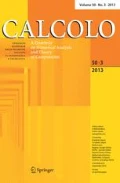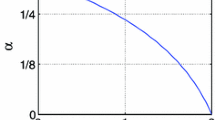Abstract
In this article, we consider monotone inclusions in real Hilbert spaces and suggest a new splitting method. The associated monotone inclusions consist of the sum of one bounded linear monotone operator and one inverse strongly monotone operator and one maximal monotone operator. The new method, at each iteration, first implements one forward–backward step as usual and next implements a descent step, and it can be viewed as a variant of a proximal-descent algorithm in a sense. Its most important feature is that, at each iteration, it needs evaluating the inverse strongly monotone part once only in the forward–backward step and, in contrast, the original proximal-descent algorithm needs evaluating this part twice both in the forward–backward step and in the descent step. Moreover, unlike a recent work, we no longer require the adjoint operation of this bounded linear monotone operator in the descent step. Under standard assumptions, we analyze weak and strong convergence properties of this new method. Rudimentary experiments indicate the superiority of our suggested method over several recently-proposed ones for our test problems.
Similar content being viewed by others
References
Lions, P.L., Mercier, B.: Splitting algorithms for the sum of two nonlinear operators. SIAM J. Numer. Anal. 16, 964–979 (1979)
Passty, G.B.: Ergodic convergence to a zero of the sum of monotone operators in Hilbert space. J. Math. Anal. Appl. 72, 383–390 (1979)
Chen, H.G., Rockafellar, R.T.: Convergence rates in forward-backward splitting. SIAM J. Optim. 7, 421–444 (1997)
Lawrence, J., Spingarn, J.E.: On fixed points of non-expansive piecewise isometric mappings. Proc. Lond. Math. Soc. 55, 605–624 (1987)
Eckstein, J., Bertsekas, D.P.: On the Douglas–Rachford splitting method and the proximal point algorithm for maximal monotone operators. Math. Program. 55(3), 293–318 (1992)
Combettes, P.L.: Solving monotone inclusions via compositions of nonexpansive averaged operators. Optimization 53, 475–504 (2004)
Dong, Y.D., Fischer, A.: A family of operator splitting methods revisited. Nonlinear Anal. 72, 4307–4315 (2010)
Dong, Y.D.: Douglas–Rachford splitting method for semi-definite programming. J. Appl. Math. Comput. 51, 569–591 (2016)
Tseng, P.: A modified forward–backward splitting method for maximal monotone mappings. SIAM J. Control Optim. 38(2), 431–446 (2000)
Dong, Y.D.: Splitting Methods for Monotone Inclusions. Ph.D. dissertation, Nanjing University (2003)
Sun, D.F.: A class of iterative methods for solving nonlinear projection equations. J. Optim. Theory Appl. 91(1), 123–140 (1996)
Solodov, M.V., Tseng, P.: Modified projection-type methods for monotone variational inequalities. SIAM J. Control Optim. 34, 1814–1830 (1996)
He, B.S.: A class of projection and contraction methods for monotone variational inequalities. Appl. Math. Optim. 35, 69–76 (1997)
Dong, Y.D.: A variable metric proximal-descent algorithm for monotone operators. J. Appl. Math. Comput. 60, 563–571 (2012)
Solodov, M.V., Svaiter, B.F.: A hybrid approximate extragradient-proximal point algorithm using the enlargement of a maximal monotone operator. Set Valued Anal. 7, 323–345 (1999)
Huang, Y.Y., Dong, Y.D.: New properties of forward–backward splitting and a practical proximal-descent algorithm. Appl. Math. Comput. 237, 60–68 (2014)
Noor, M.A.: Mixed quasi-variational inequalities. Appl. Math. Comput. 146, 553–578 (2003)
Dong, Y.D.: An LS-free splitting method for composite mappings. Appl. Math. Lett. 18(8), 843–848 (2005)
He, B.S.: Solving a class of linear projection equations. Numer. Math. 68, 71–80 (1994)
Irschara, A., Zach, C., Klopschitz, M., Bischof, H.: Large-scale, dense city reconstruction from user-contributed photos. Comput. Vis. Image Underst. 116, 2–15 (2012)
Alotaibi, A., Combettes, P.L., Shahzad, N.: Solving coupled composite monotone inclusions by successive Fejér approximations of their Kuhn-Tucker set. SIAM J. Optim. 24(4), 2076–2095 (2014)
Combettes, P.L., Eckstein, J.: Asynchronous block-iterative primal-dual decomposition methods for monotone inclusions. Math. Program. 168(1–2), 645–672 (2018)
Latafat, P., Patrinos, P.: Asymmetric forward–backward-adjoint splitting for solving monotone inclusions involving three operators. Comput. Optim. Appl. 68(1), 57–93 (2017)
Briceno-Arias, L.M., Davis, D.: Forward-backward-half forward algorithm with non self-adjoint linear operators for solving monotone inclusions. arXiv:1703.03436 (2017)
Vũ, B.C.: A splitting algorithm for dual monotone inclusions involving cocoercive operators. Adv. Comput. Math. 38(3), 667–681 (2013)
Condat, L.: A primal-dual splitting method for convex optimization involving Lipschitzian, proximable and linear composite terms. J. Optim. Theory Appl. 158(2), 460–479 (2013)
Zalinescu, C.: Convex Analysis in General Vector Spaces. World Scientific Publishing, River Edge, NJ (2002)
Brezis, H., Crandall, M.G., Pazy, A.: Perturbation of nonlinear maximal monotone sets in Banach space. Comm. Pure Appl. Math. 23, 123–144 (1970)
Agarwal, R.P., Verma, R.U.: Inexact A-proximal point algorithm and applications to nonlinear variational inclusion problems. J. Optim. Theory Appl. 144, 431–444 (2010)
Chambolle, A., Pock, T.: A first-order primal-dual algorithm for convex problems with applications to imaging. J. Math. Imaging Vis. 40(1), 120–145 (2011)
Acknowledgements
We are very grateful to Xixian Bai at Shandong University for his help in numerical experiments.
Author information
Authors and Affiliations
Corresponding author
Additional information
Publisher's Note
Springer Nature remains neutral with regard to jurisdictional claims in published maps and institutional affiliations.
Rights and permissions
About this article
Cite this article
Dong, Y., Yu, X. A new splitting method for monotone inclusions of three operators. Calcolo 56, 3 (2019). https://doi.org/10.1007/s10092-018-0299-7
Received:
Accepted:
Published:
DOI: https://doi.org/10.1007/s10092-018-0299-7




